May-viation Best Early War WWII Plane Round 1
Rules and discussion of the contest can be found here.
Voting is conducted in the forums and can be found here.
Voting results will be shown after the poll has expired. Voting will run for seven days.
A6M Zero
By Eyebiter
Japanese Navy A6M Zero was the world’s best carrier fighter in 1941. Possessing unmatched range and maneuverability, flown by highly trained Japanese pilots, the Zero dominated the skies over the Far East during the opening months of the war.
The 12-Shi Carrier Fighter specification was developed in 1937 to replace the Mitsubishi A5M Type 96 carrier fighter. It called for a fully enclosed cockpit with good visibility, retractable landing gear, long range, improved armament, and excellent maneuverability. Both Nakajima and Mitsubishi were invited to submit designs, however in early1938 Nakajima declined to continue indicating the specifications were unachievable.
The Mitsubishi design team lead by Jiro Horikoshi used a two step process to achieve the 12-Shi performance requirements – the aircraft was lightened wherever possible, and a new advanced aluminum-zinc alloy was used to construct the plane. The fuselage was constructed from one piece of aluminum for additional strength, and flush rivets were used to streamline the aircraft. To save weight self sealing fuel tanks and cockpit armor were eliminated to improve performance. The plane could be fitted with an external drop tank for greater range.
The first A6M1 prototype was completed in March 1939. After initial testing several improvements were added including a three blade propeller and more powerful Nakajima Sakae engine. One squadron of early A6M fighters was sent to China in summer 1940 for combat testing. The A6M proved far superior to Nationalist Chinese pilots flying Soviet I-15 and I-16 fighters. Based on this success, the Japanese Navy adopted the A6M as the Type 0 carrier fighter. By December 1941 approximately 420 Zeros were in service.
The Allies had ignored rumors of a new Japanese fighter operating in China for several months. As a result they were surprised by it’s long range and impressive flight performance during the opening months of the war. Early American, British, and Dutch fighters who attempted to dogfight the Japanese Zero were no match for the highly trained pilots of the Japanese Navy. The Zero reigned supreme over the Pacific throughout 1942.
During this period the Allies developed combat tactics such as the “Thatch Weave” and diving “Boom and Zoom” to counteract the maneuverability advantage of the Zero. However one of the turning points of the occurred when a crashed A6M2 was recovered from the Aleutian Islands. The Allies learned the lightweight construction of the plane also made it fragile in combat. Lessons learned from this intelligence bonanza allowed American pilots to better fight the Zero, and greatly influenced and improved future US fighter design.
By mid 1943 the Zero no longer dominated the battlefield. Veteran pilot losses at Midway, along with attrition from the Solomon Islands and New Guinea campaigns further reduced the IJN effectiveness. Compared with prewar pilots, new pilots received minimal flight training.
While the Zero soldiered on throughout the war with only minimal improvements, in late 1943 advanced American P-38 Lighting, F4U Corsair, and F6F Hellcat fighters appeared in great numbers. With the loss of IJN carriers, the land based Zero was used to escort and later participate in Kamikaze attacks. Over 11,000 including carrier, land based, and float plane variants were produced by wars end.
Versus
The Grumman F4F Wildcat
Submitted by Jack Nastyface
In considering this article, I contemplate a simple question: How should one rate an airplane? What are the hallmark traits that determine a “good” airplane? Airspeed? Ceiling? Armament? Or something else?
I’ll start with airframe. The F4F does not have the nicest lines of all the early war fighters. It has a short, round airframe with rectangular wings, giving the airplane a decidedly “stubby” appearance. Sounds like an ex-girlfriend? Maybe…but like that ex-girlfriend, the Wildcat put out where others can’t, don’t or won’t.
The Wildcat was faster than most of its contemporary Japanese rivals, with a superior dive speed and roll rate. Admittedly, it was outclassed by its main rival, A6M zero, in top speed, climb rate, and low speed manoeuvrability, but let’s consider why: The Wildcat featured protective armor plating for the pilot, a radio for air-to-air and air-to-ground communication, and self-sealing fuel-tanks. Take those away and you have a faster plane that tends to catch fire, flown by a pilot with limited life-span who fights in silence and isolation from his comrades.
And the engine? The Wildcat was powered by the Pratt & Whitney 14-cylinder twin-radial engine that generated a respectable 1200 HP for a top speed of 330 MPH, a ceiling of 39,500 feet, and a range of 845 miles. A key advantage of the radial engine is that it maintains power throughout complex air combat manoeuvres, unlike certain in-line counterparts (cough-spitfire-hurricane-cough). And although it may be ungainly in appearance compared to sleek in-line liquid-cooled engines, the radial engine was easier to maintain in the rough conditions of carrier and island war. In fact, the Pratt and Whitney on the Wildcat was the same engine used on many other WWII aircraft (such as the Liberator, the Catalina, C-47/DC-3 Skytrain, and the Short Sunderland) effectively easing the burden on spare parts, maintenance, supply, and logistics, all decidedly critical factor in the vast Pacific Theatre.
Just as important as performance is armament. The Wildcat F4F-3 model featured four .50 caliber M2 machine guns, each loaded with 450 rounds of ammunition. This makes the Wildcat superior not only to its Pacific War rivals, but it bests almost every other early war fighter. Here’s the math: Using the simple algorithm of bullet weight x number of bullets per gun x number of guns per plane, we can determine the total weight, in lbs, of each planes aerial gun armament.
F4F Wildcat: 170
Hurricane: 62
A6M Zero: 63
Spitfire 56
BF 109: 83
D520: 77
La-5: 118
P-40E: 134
Interestingly, later versions of the F4F featured six M2 guns, but the additional weight meant fewer rounds per gun. Many pilots actually preferred the early war configuration, which stands as testament to the Wildcat’s lethality.
In addition to her wing mounted MG’s, the Wildcat was capable of carrying two 100lb bombs. Capt. Henry Elrod used these to telling effect during the defense of Wake Island when he repeatedly attacked and eventually sunk the Japanese destroyer Kisaragi, marking the first such victory for a fighter plane in WW2.
Wake Island was but one engagement where the Wildcat proved its worth. The battle honors for the F4F include virtually all of the hallmark engagements of the Pacific War, notably Coral Sea, Midway, Eastern Solomons, and Guadalcanal (with the Cactus Air Force). In fact, Wildcats accounted for over 1000 enemy kills in the Pacific theatre, achieving in some cases a 7 – 1 kill ratio. In Europe, the Wildcat saw service as the Marlet, and played a vital role in coastal defense and anti-submarine patrols.
No less famous than the F4F Wildcat are the men who flew this fine plane. Capt. Elrod was awarded the Congressional Medal of Honor for his actions at Wake. So were Maj. John Smith, Lt. Col Harold Bauer, , Lt. Robert Galer, Capt. Joe Foss, and Lt. Cmdr. Edward “Butch” O’Hare. And it was Wildcat pilot, Lt. Cmdr John Thach, who created the beam defense tactic – known as the Thach Weave – which remained in use as an effective air combat maneuver during the Vietnam War.
It is undeniable that Victory in the Pacific occurred because of the aircraft carrier. And until 1943, it is the Wildcat that protects those carriers.
And this pairing:
Voting is conducted in the forums and can be found here.
Voting results will be shown after the poll has expired. Voting will run for seven days.
Make way for the Bf 109!
By Centurion40
First off, the design is exquisite. Take a look, drink it in!
The Bf 109 first saw service with the Condor Legion during the Spanish Civil War, and was still in service at the end of WWII. Variations of the original Bf 109 design remained in service after WWII, some remained in service as late as the 1960s; a testament to the Bf 109 design and durability.
Bf 109s, and their variants, were obtained for the following nation’s Air Forces: Germany, Italy, Finland, Switzerland, Bulgaria, Croatia, Czechoslovakia, Hungary, Israel, Japan, Romania, Spain, Slovak Republic, and Yugoslavia. Another testimony to the superiority of the Bf 109 design.
In 1937, a Bf 109 set a world airspeed record for piston engines. In 1939, a variation of the Bf 109 set a piston engine airspeed record that held until 1969!! Thirty years!! Take that, Spitfire!
The Bf 109 is noted to have more aerial kills than any other aircraft of WWII. I’ll say that again, the Bf 109 had more aerial kills than any other aircraft of WWII! There were 105 Bf 109 pilots credited with the destruction of over 100 enemy aircraft, 13 of these pilots had over 200 kills each.
It could be argued that this contest is limited to the 1941 variant of the Bf 109 (up to, and including the Bf 109F), and that the 109’s kills were not all made by 109 variants built before 1942; and that would be true. But my point is that the Bf 109s built before 1942 were the template, tried and true, that were so effective that Germany kept updating them and pumping them out; rather than scraping them and going with a different air frame model.
The Bf 109, speed, firepower and mobility make it the clear winner.
Versus
Macchi C.202
By Windigo
Here are names of a few Italian manufacturers; Ferrari, Lamborghini, Maserati, and Alfa Romeo. Names of sports car manufacturers who have attained legendary status for their legendary vehicles. High performance vehicles that dominate their world competition. These vehicles not only have unbeatable performance, they also have flair, elan and stylish good looks.
So would you expect anything different from Italy when they developed and produced a World War 2 fighter plane? Hardly not I say! The Macchi C.202 was “Italia ” to its aerelons It was fast, very manoueverable across its whole operational altitude range, internally strong, packed a fair punch, was a great high speed diver and it could hold its own against anything it faced. Alfa Romeo manufactured engines and Macchi airframe constuction design gave this exotic streamlined beauty a very favourable horsepower to weight ratio and an impressive wingloading. Experienced Allied fighter pilots like Clive Caldwell who fought against German, Italian, and Japanese fighters in both major theatres of World War II, from 1941 – 1945, said that the C.202 was one of the best and most undervalued of fighters. That says a great deal.
So what truly then separates a very good airplane type from the rest of the nominees? Why stylish good looks of course and the Macchi C.202 had it in spades!


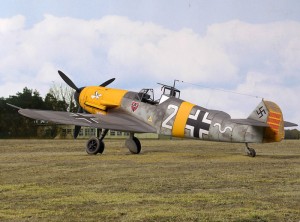
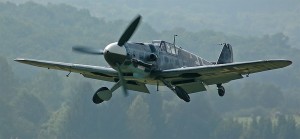
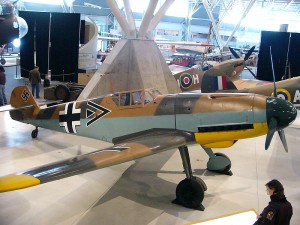
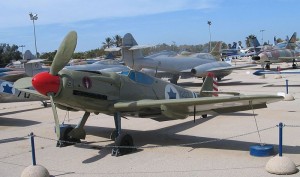
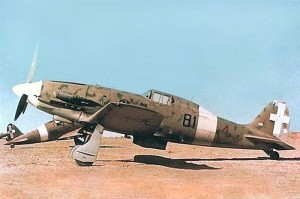

Leave a Reply